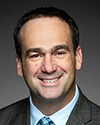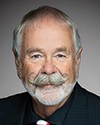Good afternoon, Madam Chair, and members of the committee.
Thank you for the opportunity to appear before this committee today.
Parks Canada is recognized as a world leader in conservation. My remarks will provide you with details on Parks Canada's work to protect and present our protected places in northern Ontario where we manage a number of land- and water-based natural and cultural sites along the north shore of Lake Superior. They are situated in this rugged part of Canada along the Trans-Canada Highway.
My presentation will speak to my management experiences in support of ecological integrity including monitoring, restoration and providing meaningful experiences to our visitors. You will see through my examples that relationships with local communities, other government departments and indigenous communities are at the heart of how we operate and how we collectively enrich the experience of our visitors.
Established in 1978, Pukaskwa National Park is located on the north shore of Lake Superior, protecting 1,878 square kilometres of ecosystems, including boreal forest and rugged Canadian Shield.
An ecological integrity monitoring program has been implemented to monitor the long-term trends and health of Lake Superior ecosystems, both terrestrial and aquatic. Data is collected by park staff but also as part of an innovative collaboration with Lakehead University.
Since 2013, Lakehead University has held a field course in the park for its environmental science students. The course contributes to the work we do while providing students the opportunity to engage, experience, and learn about conservation and protection in our national heritage places.
Another example is the citizen scientists who are engaged in annual monitoring of the threatened peregrine falcon along Pukaskwa's coast. Each spring, Parks Canada staff and members of Project Peregrine survey known peregrine falcon territories within the park. In 2016, the highest number of active territories to date, five, were recorded in the park.
In addition to ecological monitoring, Pukaskwa is also actively restoring natural ecosystems through the reintroduction of fire on the landscape. Since 1998, the park has burned over 1,400 hectares of boreal forest, helping to restore key habitat. This program represents an opportunity for the agency to share our knowledge of the role of fire in ecosystems with park visitors who can take a walk through a prescribed burn area that includes interpretive panels explaining the role of fire in a healthy ecosystem.
Collaborations with other departments are ongoing and contribute to our focus on ecological integrity. The Pukaskwa National Park and Fathom Five National Marine Park are collaborating on a multi-year study with Environment and Climate Change Canada to assess impacts of diet on fish-eating birds and its relation to declining populations of herring gull.
Another example is a partnership with Ontario's Ministry of Natural Resources and Forestry, and with Fisheries and Oceans Canada, to ensure that Lake Superior's ecosystems remain healthy and viable for fish species such as lake sturgeon, lake trout and brook trout.
Parks Canada is also an important partner to the Great Lakes water quality agreement. The Lake Superior National Marine Conservation Area makes a significant contribution to the objectives in that agreement, through the protection of one third of the Canadian waters of Lake Superior.
Parks Canada also participated in the Lake Superior partnership working group, which produced the newly released Lake Superior lakewide action and management plan.
Parks Canada works with more than 300 indigenous communities across Canada in conserving, restoring and presenting Canada's natural and cultural heritage. Northern Ontario is no exception. Examples of this include a program where Anishnaabe teachings are brought to life with guided hikes along part of our trail networks.
Recently, the redevelopment of the traditional Anishnaabe camp immediately in the park's main visitor reception area engage the local community to build traditional birchbark structures including a tipi, cook tent and wigwam. Visitors passing by or participating in our guided hikes were able to witness traditional building methods in action and to speak with local knowledge-holders.
The Lake Superior national marine conservation area, once formally established under the Canada National Marine Conservation Areas Act, will protect almost 13% of the lake, including 10,880 square kilometres of lakebed, over 600 islands, the water column and all living things in it.
The completion of the interim management plan released earlier this year reconfirmed the vision established in 2002 and is an example of Parks Canada's collaboration with partner indigenous organizations, the Province of Ontario, other federal agencies, and coastal communities. As the national marine conservation area becomes operational, local indigenous communities are helping to define all aspects of its operation.
Canada's national parks and marine conservation areas are gateways to nature, adventure, and discovery, and Parks Canada will continue to connect Canadians with their heritage.
As we near the 150th anniversary of Confederation in 2017, we are inviting Canadians to experience and learn more about our environment and our heritage. For example, the Pukaskwa National Park currently welcomes approximately 9,500 visitors per year and looks forward to welcoming more visitors for this special year.
Next year, a new trail will open at Pukaskwa, which, while linked to the iconic coastal hiking trail, will offer a more accessible hiking experience for visitors. The trail has been designed in collaboration with indigenous partners to include a focus on indigenous culture through the presence of interpretive panels and learning opportunities.
Canada's two national marine conservation areas in the Great Lakes region provide incredible living laboratories for freshwater research. As protected areas, they provide a baseline for understanding lake ecosystem health.
As part of our operations, we ensure that ecological integrity is the first consideration in the management of our national parks. Ecological integrity and visitor experience are not mutually exclusive; both are essential to ensuring that visitors will create lasting connections to our places. Within our marine conservation areas, ecological sustainable use is the management goal.
Parks Canada is strongly committed to working in partnership and collaboration with indigenous peoples, communities, municipalities and other stakeholders to ensure that Canada's heritage areas are protected for future generations.
Through planning initiatives, partnering opportunities, public outreach and education, Parks Canada is informing Canadians about the importance of protecting these special places and encouraging stewardship of our natural and cultural resources for present and future generations.
Thank you.




